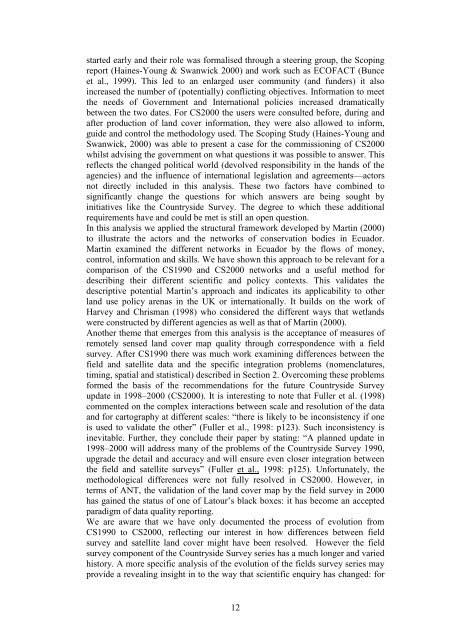Actor Network Theory - Leicester Research Archive - University of ...
Actor Network Theory - Leicester Research Archive - University of ...
Actor Network Theory - Leicester Research Archive - University of ...
Create successful ePaper yourself
Turn your PDF publications into a flip-book with our unique Google optimized e-Paper software.
started early and their role was formalised through a steering group, the Scoping<br />
report (Haines-Young & Swanwick 2000) and work such as ECOFACT (Bunce<br />
et al., 1999). This led to an enlarged user community (and funders) it also<br />
increased the number <strong>of</strong> (potentially) conflicting objectives. Information to meet<br />
the needs <strong>of</strong> Government and International policies increased dramatically<br />
between the two dates. For CS2000 the users were consulted before, during and<br />
after production <strong>of</strong> land cover information, they were also allowed to inform,<br />
guide and control the methodology used. The Scoping Study (Haines-Young and<br />
Swanwick, 2000) was able to present a case for the commissioning <strong>of</strong> CS2000<br />
whilst advising the government on what questions it was possible to answer. This<br />
reflects the changed political world (devolved responsibility in the hands <strong>of</strong> the<br />
agencies) and the influence <strong>of</strong> international legislation and agreements—actors<br />
not directly included in this analysis. These two factors have combined to<br />
significantly change the questions for which answers are being sought by<br />
initiatives like the Countryside Survey. The degree to which these additional<br />
requirements have and could be met is still an open question.<br />
In this analysis we applied the structural framework developed by Martin (2000)<br />
to illustrate the actors and the networks <strong>of</strong> conservation bodies in Ecuador.<br />
Martin examined the different networks in Ecuador by the flows <strong>of</strong> money,<br />
control, information and skills. We have shown this approach to be relevant for a<br />
comparison <strong>of</strong> the CS1990 and CS2000 networks and a useful method for<br />
describing their different scientific and policy contexts. This validates the<br />
descriptive potential Martin‘s approach and indicates its applicability to other<br />
land use policy arenas in the UK or internationally. It builds on the work <strong>of</strong><br />
Harvey and Chrisman (1998) who considered the different ways that wetlands<br />
were constructed by different agencies as well as that <strong>of</strong> Martin (2000).<br />
Another theme that emerges from this analysis is the acceptance <strong>of</strong> measures <strong>of</strong><br />
remotely sensed land cover map quality through correspondence with a field<br />
survey. After CS1990 there was much work examining differences between the<br />
field and satellite data and the specific integration problems (nomenclatures,<br />
timing, spatial and statistical) described in Section 2. Overcoming these problems<br />
formed the basis <strong>of</strong> the recommendations for the future Countryside Survey<br />
update in 1998–2000 (CS2000). It is interesting to note that Fuller et al. (1998)<br />
commented on the complex interactions between scale and resolution <strong>of</strong> the data<br />
and for cartography at different scales: ―there is likely to be inconsistency if one<br />
is used to validate the other‖ (Fuller et al., 1998: p123). Such inconsistency is<br />
inevitable. Further, they conclude their paper by stating: ―A planned update in<br />
1998–2000 will address many <strong>of</strong> the problems <strong>of</strong> the Countryside Survey 1990,<br />
upgrade the detail and accuracy and will ensure even closer integration between<br />
the field and satellite surveys‖ (Fuller et al., 1998: p125). Unfortunately, the<br />
methodological differences were not fully resolved in CS2000. However, in<br />
terms <strong>of</strong> ANT, the validation <strong>of</strong> the land cover map by the field survey in 2000<br />
has gained the status <strong>of</strong> one <strong>of</strong> Latour‘s black boxes: it has become an accepted<br />
paradigm <strong>of</strong> data quality reporting.<br />
We are aware that we have only documented the process <strong>of</strong> evolution from<br />
CS1990 to CS2000, reflecting our interest in how differences between field<br />
survey and satellite land cover might have been resolved. However the field<br />
survey component <strong>of</strong> the Countryside Survey series has a much longer and varied<br />
history. A more specific analysis <strong>of</strong> the evolution <strong>of</strong> the fields survey series may<br />
provide a revealing insight in to the way that scientific enquiry has changed: for<br />
12














